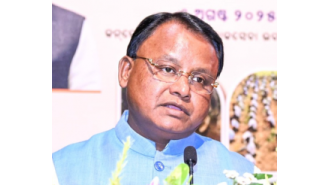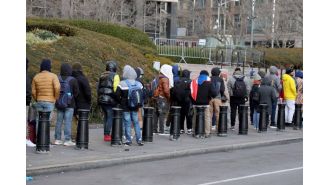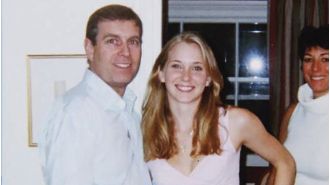Lifting the Veil on Another Batch of Shadowy Trump Appointees
The administration continues to quietly hire political staffers — more than 1,000 so far, many of them regulating industries they previously worked for — but we’ve uncovered more identities. “The swamp continues,” says a Trump campaign official who is now a lobbyist.

President Donald Trump has left hundreds of government jobs unfilled that require a vote by the Senate. Yet his administration has installed more than 1,000 people through political appointments at every major federal agency, handing over control of the government’s day-to-day operations to industry insiders and loyalists to an unprecedented degree.
Among the latest Trump administration appointees is a lobbyist who until March worked for a leading hepatitis C drugmaker that priced its treatment at $1,000 a pill and is now leading a White House working group setting drug pricing policies. The list includes the new head of the government’s offshore oil drilling safety and enforcement agency, who previously sat on the board of Sunoco Logistics and who told an industry conference earlier this month that deepwater drilling should ramp up. Then there’s the Hollywood actor who has called global warming and climate change a “leftist political tool” and “not sound science” on Twitter and who is now the communications director at the Department of Health and Human Services. Finally, this group also includes the 80-year-old retired chief legal officer of Morgan Stanley, who once told government lawyers he was “going to kick your ass” and is now a deputy attorney general in the Justice Department’s antitrust division, overseeing litigation while his boss awaits Senate confirmation. (At the time, Kempf denied using the expletive in exactly those terms.)
These political appointees, some of them members of what have been dubbed “beachhead teams” during the presidential transition, and others who are now permanent employees, don’t need Senate confirmation. Many of them have operated in the shadows and the White House has declined to publicly reveal their identities. Some political appointees, such as Commerce Secretary Wilbur Ross’s chief of staff, Wendy Teramoto, were initially hired as special government employees, or SGEs. They are brought on as temporary advisers and don’t face the same rules that other federal employees do. But Teramoto and others have stuck around, and been promoted to permanent jobs. The administration reveals virtually nothing about this category of staffers.
“As long as you know who to call, they are more than willing to work with ‘industry,’” said Scott Mason, a Trump campaign veteran who’s now a lobbyist with Holland & Knight. “The swamp continues as the ecosystem it has always been, advocating on behalf of Americans who are all represented in one way or another by an interest group.”
We now have a full list from the Office of Personnel Management, the federal government’s human resources department, and it counts more than 1,000 political appointments since Trump took office on Jan. 20. The 1,000 include some 400 that ProPublica first revealed in March, and another 140 that were added in subsequent updates. We found that of the roughly 500 new appointees on our list, at least 61 have been registered lobbyists at the federal level. (This is likely an undercount since it does not include those who have not registered or who worked solely on the state level.)
We found at least 44 people who have been rehired for second stints in the same government jobs after their initial terms expired. Another 194 people have been given new jobs after their initial beachhead terms.
“The pool of ‘Trump Republicans’ was small so that they had to go to regular Republicans, a lot of whom worked for the Bush administration,” said Ivan Adler, a lobbying headhunter with the McCormick Group. “And there happen to be a lot of lobbyists among that group.”
We’re still sorting through the new names and we want your help. If you have tips or want to flag someone for us, email [email protected].
“What’s unusual is the size and scope of these teams,” said Max Stier, president and CEO of the Partnership for Public Service, which advises both Republican and Democratic presidential administrations on transitions. “The normal process in filling your political team is going from the campaign to the transition team to a political appointment. The cabinet picks manage all of this. But without them, the beachhead teams have been in charge. It’s added a whole other level of confusion to an already difficult process.”
It has also added a layer of shadows, said Jeff Hauser, who runs the Revolving Door Project at the D.C.-based Center for Economic and Policy Research. “These are political appointees who are subjected to much less scrutiny than if they went through the Senate-confirmed process,” he said. “And these special employees, many of whom are on short stints and go back to regulated industries, are not answerable to anyone except the White House. It’s an outsourcing of government.”
Dozens of original beachhead team members have left government altogether, with several returning to lobbying or other industry-advocacy work. Donald Schnare, a lawyer and longtime critic of the EPA named to that agency’s beachhead team in December, resigned in March after infighting between political appointees and the hand-picked staff of EPA Administrator Scott Pruitt boiled over. Schnare told ProPublica that nearly every member of the Trump administration beachhead team at the EPA were refused permanent jobs by Pruitt.
Meanwhile, the Trump administration is lagging in nominating key leaders to government jobs that require a vote of the Senate. As of the August congressional recess, the Trump administration has nominated 277 people for Senate confirmation and just 44 percent have been confirmed, according to the Partnership for Public Service. By comparison, the previous four presidential administrations — those of Barack Obama, George W. Bush, Bill Clinton and George H.W. Bush — had nominated at least 315 people by the August recess and had their picks confirmed at rates above 60 percent at that point in the process.
To fill the gaps, the White House placed at least 18 “senior White House advisers” at federal agencies, to act as the administration’s eyes and ears. Many were Trump campaign staffers and loyalists with little to no government experience and they publicly clashed with several of Trump’s top Cabinet picks, including Treasury secretary Steve Mnuchin and Transportation secretary Elaine Chao.
Staffing records show that at least 11 of these advisers have left their original jobs or departed the government. (Several advisers, such as Paula Stannard at Health and Human Services, Mary Anne Bradfield at the Small Business Administration and Maren Kasper at the Department of Housing and Urban Development, were promoted to permanent positions.)
But seven still remain, including Sam Clovis, a former radio host whose nomination as the Agriculture Department’s chief scientist is pending. (Clovis has attracted press scrutiny for, among other statements, his assertions that he is “extremely skeptical” about climate change.)
Here are a few Trump political appointees we’ve found:






